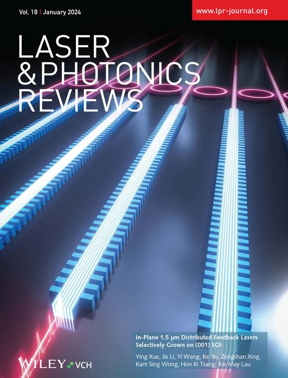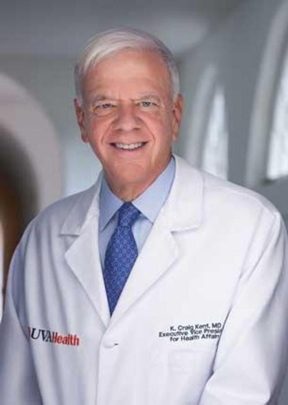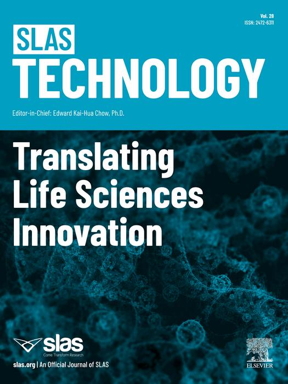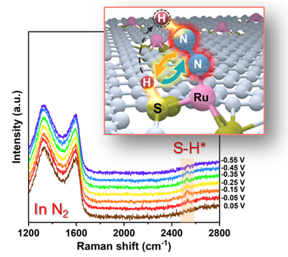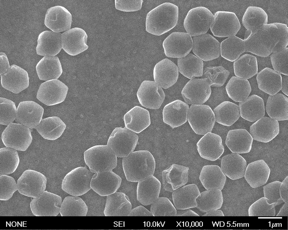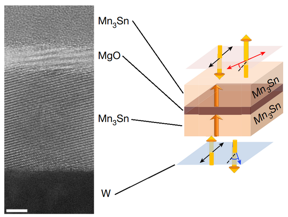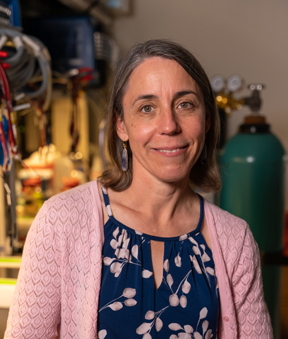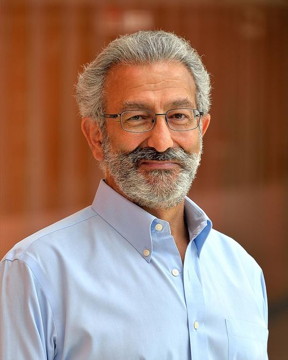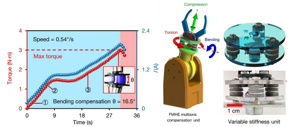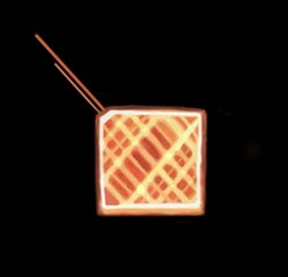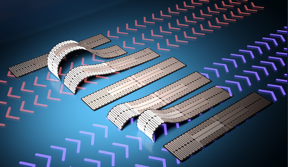Home > Press > HKUST researchers develop new integration technique for efficient coupling of III-V and silicon
| The study was selected as cover of the journal Laser & Photonics Reviews. CREDIT HKUST |
Abstract:
Researchers at the Hong Kong University of Science and Technology (HKUST) have developed a new integration technique for efficient integration of III-V compound semiconductor devices and silicon, paving the way for photonic integration at low cost, large volume, and high speed and throughput that could revolutionize data communications.
HKUST researchers develop new integration technique for efficient coupling of III-V and silicon
Hong Kong, China | Posted on February 16th, 2024
Unlike conventional integrated circuits, or microchips, that use electrons, photonic integrated circuits use photons, or particles of light. Photonic integration combines light and electronics to speed up data transfer. Silicon photonics (Si-photonics), in particular, is at the forefront of this revolution as it enables the creation of high-speed, low-cost connections that can handle massive amounts of data at once.
While silicon can handle passive optical functions, it struggles with active tasks, such as generating light (lasers) or detecting it (photodetectors) – both key components for data generation and readout. This necessitates the integration of III-V semiconductor (which uses materials from groups III and V of the periodic table) onto a silicon substrate for complete functionality and enhanced efficiency.
But while III-V semiconductors do the active tasks well, they do not naturally work well with silicon. The team, led by Prof. Ying XUE, Research Assistant Professor and Prof. Kei May LAU, Research Professor of the Division of Emerging Interdisciplinary Areas (EMIA), tackled this challenge by finding a way to make III-V devices work efficiently with silicon.
They developed a technique called lateral aspect ratio trapping (LART) – a novel selective direct epitaxy method that can selectively grow III-V materials on silicon-on-insulator (SOI) in a lateral direction without the need for thick buffers.
While no integration methods reported in literature could solve the challenge with high coupling efficiency and high production volume, their method achieved an in-plane III-V laser, so that the III-V laser can couple with Si in the same plane, which is efficient.
“Our approach addressed the mismatch of III-V devices and Si. It achieved excellent performance of III-V devices and made it easy and efficient to couple III-V with Si,” Prof. XUE said.
In the past decades, data traffic has grown exponentially driven by emerging technologies, such as big data, cloud applications, and sensors. The field of integrated circuits (ICs), also known as microelectronics, has enabled that growth by making electronic devices smaller and faster thanks to Moore’s Law, an observation that the number of transistors on a microchip doubles about every two years. But the continued explosion of data traffic has pushed traditional electronic devices to their limits.
The start of the Zettabyte Era in 2016 ushered in soaring growth in data generation, processing, transmission, storage, and readout. This surge in data poses critical challenges of speed, bandwidth, cost, and power consumption. This is where photonic integration, in particular Si-photonics, comes in.
In the next steps, the team plans to show that III-V lasers integrated with silicon waveguides can perform well, as in having a low threshold, high output power, long lifetime, and the ability to operate at high temperatures.
There are key scientific challenges to address before this technique could be used in real life, she said. But it will enable new-generation communications and various emerging applications and research areas, including supercomputers, artificial intelligence (AI), biomedicine, automotive applications, and neural and quantum networks.
The study was recently published in the journal Laser & Photonics Reviews and selected as cover.
On a related note, Prof. Xue recently received a grant worth US$100,000 from the 2023 Optica Foundation Challenge for her innovations in mitigating the limitations associated with photonic integrated circuits. The grant will be used to advance her research.
####
For more information, please click here
Contacts:
Janice Tsang
Hong Kong University of Science and Technology
Copyright © Hong Kong University of Science and Technology
If you have a comment, please Contact us.
Issuers of news releases, not 7th Wave, Inc. or Nanotechnology Now, are solely responsible for the accuracy of the content.
| Related Links |
| Related News Press |
News and information
![]() Detecting breast cancer through a spit test February 16th, 2024
Detecting breast cancer through a spit test February 16th, 2024
![]() New chip opens door to AI computing at light speed February 16th, 2024
New chip opens door to AI computing at light speed February 16th, 2024
![]() Under pressure – space exploration in our time: Advancing space exploration through diverse collaborations and ethical policies February 16th, 2024
Under pressure – space exploration in our time: Advancing space exploration through diverse collaborations and ethical policies February 16th, 2024
Wireless/telecommunications/RF/Antennas/Microwaves
Quantum communication
![]() Discovery made by University of Warsaw scientists may enable network interface for quantum computers October 6th, 2023
Discovery made by University of Warsaw scientists may enable network interface for quantum computers October 6th, 2023
![]() IOP Publishing celebrates World Quantum Day with the announcement of a special quantum collection and the winners of two prestigious quantum awards April 14th, 2023
IOP Publishing celebrates World Quantum Day with the announcement of a special quantum collection and the winners of two prestigious quantum awards April 14th, 2023
Possible Futures
![]() Detecting breast cancer through a spit test February 16th, 2024
Detecting breast cancer through a spit test February 16th, 2024
![]() A battery’s hopping ions remember where they’ve been: Seen in atomic detail, the seemingly smooth flow of ions through a battery’s electrolyte is surprisingly complicated February 16th, 2024
A battery’s hopping ions remember where they’ve been: Seen in atomic detail, the seemingly smooth flow of ions through a battery’s electrolyte is surprisingly complicated February 16th, 2024
![]() NRL discovers two-dimensional waveguides February 16th, 2024
NRL discovers two-dimensional waveguides February 16th, 2024
Chip Technology
![]() New chip opens door to AI computing at light speed February 16th, 2024
New chip opens door to AI computing at light speed February 16th, 2024
![]() NRL discovers two-dimensional waveguides February 16th, 2024
NRL discovers two-dimensional waveguides February 16th, 2024
![]() ‘Sudden death’ of quantum fluctuations defies current theories of superconductivity: Study challenges the conventional wisdom of superconducting quantum transitions January 12th, 2024
‘Sudden death’ of quantum fluctuations defies current theories of superconductivity: Study challenges the conventional wisdom of superconducting quantum transitions January 12th, 2024
Optical computing/Photonic computing
![]() New chip opens door to AI computing at light speed February 16th, 2024
New chip opens door to AI computing at light speed February 16th, 2024
![]() NRL discovers two-dimensional waveguides February 16th, 2024
NRL discovers two-dimensional waveguides February 16th, 2024
![]() Thermal impact of 3D stacking photonic and electronic chips: Researchers investigate how the thermal penalty of 3D integration can be minimized December 8th, 2023
Thermal impact of 3D stacking photonic and electronic chips: Researchers investigate how the thermal penalty of 3D integration can be minimized December 8th, 2023
![]() Successful morphing of inorganic perovskites without damaging their functional properties October 6th, 2023
Successful morphing of inorganic perovskites without damaging their functional properties October 6th, 2023
Discoveries
![]() Superbug killer: New synthetic molecule highly effective against drug-resistant bacteria February 16th, 2024
Superbug killer: New synthetic molecule highly effective against drug-resistant bacteria February 16th, 2024
![]() A battery’s hopping ions remember where they’ve been: Seen in atomic detail, the seemingly smooth flow of ions through a battery’s electrolyte is surprisingly complicated February 16th, 2024
A battery’s hopping ions remember where they’ve been: Seen in atomic detail, the seemingly smooth flow of ions through a battery’s electrolyte is surprisingly complicated February 16th, 2024
Announcements
![]() Detecting breast cancer through a spit test February 16th, 2024
Detecting breast cancer through a spit test February 16th, 2024
![]() New chip opens door to AI computing at light speed February 16th, 2024
New chip opens door to AI computing at light speed February 16th, 2024
![]() Superbug killer: New synthetic molecule highly effective against drug-resistant bacteria February 16th, 2024
Superbug killer: New synthetic molecule highly effective against drug-resistant bacteria February 16th, 2024
Interviews/Book Reviews/Essays/Reports/Podcasts/Journals/White papers/Posters
![]() Detecting breast cancer through a spit test February 16th, 2024
Detecting breast cancer through a spit test February 16th, 2024
![]() New chip opens door to AI computing at light speed February 16th, 2024
New chip opens door to AI computing at light speed February 16th, 2024
Artificial Intelligence
![]() New chip opens door to AI computing at light speed February 16th, 2024
New chip opens door to AI computing at light speed February 16th, 2024
![]() 2D material reshapes 3D electronics for AI hardware December 8th, 2023
2D material reshapes 3D electronics for AI hardware December 8th, 2023
![]() Data can now be processed at the speed of light! April 14th, 2023
Data can now be processed at the speed of light! April 14th, 2023
Photonics/Optics/Lasers
![]() New chip opens door to AI computing at light speed February 16th, 2024
New chip opens door to AI computing at light speed February 16th, 2024
![]() A battery’s hopping ions remember where they’ve been: Seen in atomic detail, the seemingly smooth flow of ions through a battery’s electrolyte is surprisingly complicated February 16th, 2024
A battery’s hopping ions remember where they’ve been: Seen in atomic detail, the seemingly smooth flow of ions through a battery’s electrolyte is surprisingly complicated February 16th, 2024
![]() NRL discovers two-dimensional waveguides February 16th, 2024
NRL discovers two-dimensional waveguides February 16th, 2024
![]() Development of zinc oxide nanopagoda array photoelectrode: photoelectrochemical water-splitting hydrogen production January 12th, 2024
Development of zinc oxide nanopagoda array photoelectrode: photoelectrochemical water-splitting hydrogen production January 12th, 2024
- SEO Powered Content & PR Distribution. Get Amplified Today.
- PlatoData.Network Vertical Generative Ai. Empower Yourself. Access Here.
- PlatoAiStream. Web3 Intelligence. Knowledge Amplified. Access Here.
- PlatoESG. Carbon, CleanTech, Energy, Environment, Solar, Waste Management. Access Here.
- PlatoHealth. Biotech and Clinical Trials Intelligence. Access Here.
- Source: http://www.nanotech-now.com/news.cgi?story_id=57452
- :has
- :is
- :not
- :where
- $UP
- 000
- 10
- 12th
- 14th
- 16th
- 2%
- 2016
- 2023
- 26
- 30th
- 3d
- 3rd
- 4
- 6th
- 7th
- 8th
- a
- ability
- About
- accuracy
- achieved
- active
- acute
- address
- addressed
- advance
- advancing
- against
- AI
- also
- amounts
- an
- and
- Announcement
- applications
- approach
- April
- ARE
- areas
- Array
- artificial
- artificial intelligence
- Artificial intelligence (AI)
- AS
- aspect
- Assistant
- associated
- At
- automotive
- Bandwidth
- based
- batteries
- BE
- been
- before
- Big
- Big Data
- both
- Breast cancer
- but
- by
- called
- CAN
- Cancer
- celebrates
- Center
- CGI
- challenge
- challenges
- China
- chip
- Chips
- circuits
- click
- Cloud
- cloud applications
- collaborations
- collection
- COM
- combines
- comes
- comment
- Communications
- Compensation
- complete
- components
- Compound
- computing
- conductor
- conducts
- Connections
- consumption
- content
- continued
- conventional
- Cost
- cost-effective
- could
- Couple
- cover
- Creating
- creation
- credit
- critical
- Current
- damaging
- data
- day
- Death
- decades
- December
- del
- detail
- detecting
- develop
- developed
- device
- Devices
- direct
- direction
- discovered
- Discovers
- discovery
- Dispersion
- diverse
- Division
- do
- Door
- doubles
- driven
- easy
- Effective
- efficiency
- efficient
- efficiently
- electrolyte
- Electronic
- Electronics
- electrons
- emerging
- emerging technologies
- enable
- enabled
- enables
- end
- energy
- enhanced
- Era
- Errors
- Ether (ETH)
- ethical
- Every
- excellent
- expected
- exploration
- explosion
- exponentially
- far
- faster
- February
- fibers
- field
- finding
- First
- flow
- fluctuations
- For
- forefront
- Foundation
- from
- functional
- functionality
- functions
- further
- generating
- generation
- gif
- Global
- grant
- Group’s
- Grow
- grown
- Growth
- handle
- Have
- having
- Health
- her
- High
- highly
- HKUST
- Hong
- Hong Kong
- How
- http
- HTTPS
- huge
- human
- hydrogen
- ICS
- if
- iii
- Impact
- in
- Inc.
- Including
- information
- innovations
- inorganic
- integrated
- integration
- Intelligence
- Interface
- Internet
- investigate
- IT
- January
- journal
- jpg
- june
- Key
- killer
- known
- Kong
- large
- laser
- lasers
- Lau
- Law
- Led
- less
- li
- Life
- lifetime
- light
- limitations
- limits
- links
- literature
- lithium
- Long
- Low
- low-cost
- lowering
- made
- make
- Making
- massive
- material
- materials
- May..
- method
- methods
- mitigating
- molecule
- more
- multiple
- nanotechnology
- naturally
- necessitates
- Need
- net
- network
- networks
- Neural
- New
- news
- next
- next-generation
- no
- note
- novel
- November
- now
- number
- observation
- october
- of
- on
- once
- onto
- opens
- operate
- optical
- or
- organic
- our
- output
- particular
- passive
- past
- pave
- Paving
- perform
- performance
- periodic
- Photons
- PHP
- plane
- plans
- plato
- Plato Data Intelligence
- PlatoData
- please
- poses
- Post
- posted
- potential
- power
- press
- Press Release
- pressure
- prestigious
- processed
- processing
- produce
- Production
- prof
- Professor
- published
- Publishing
- pushed
- Quantum
- quantum networks
- rapidly
- ratio
- readout
- real
- real life
- received
- recently
- related
- release
- Releases
- remember
- Reported
- research
- researchers
- reshapes
- responsible
- return
- Reviews
- Revolution
- revolutionary
- revolutionize
- Risk
- Room
- safely
- Said
- same
- Save
- Science
- Science and Technology
- scientific
- scientists
- Screen
- Search
- seemingly
- seen
- selected
- selective
- semiconductor
- Semiconductors
- sensors
- Share
- she
- show
- Shows
- significantly
- Silicon
- smaller
- smooth
- So
- soaring
- solely
- solid
- SOLVE
- Source
- Space
- space exploration
- special
- speed
- stacking
- start
- Step
- Steps
- storage
- Struggles
- Study
- submit
- substrate
- such
- sudden
- supercomputers
- Superconductivity
- surge
- surprisingly
- sustainable
- synthetic
- table
- tackle
- tasks
- team
- technique
- Technologies
- Technology
- than
- thanks
- that
- The
- their
- thermal
- they
- this
- threshold
- Through
- throughput
- time
- to
- towards
- traditional
- traffic
- transfer
- transmission
- trapping
- trial
- two
- university
- unlocks
- us
- use
- used
- uses
- ushered
- various
- volume
- Warsaw
- was
- Waste
- Water
- Wave
- Way..
- WELL
- which
- while
- will
- winners
- wisdom
- with
- without
- Work
- world
- worth
- Yahoo
- years
- YING
- you
- zephyrnet

